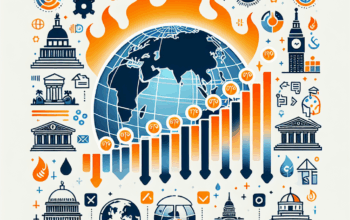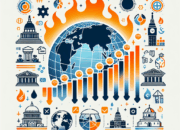Introduction
In 2025, trade policies continue to shape the global market dynamics significantly, influencing economic growth, job creation, and international relations. As nations navigate the complexities of globalization, the governmental policies governing trade practices play a pivotal role in defining relationships between economies. This article explores the influence of trade policies on global market dynamics, delving into tariffs, trade agreements, and economic sanctions, and examines how these elements interact to mold the economic landscape of countries worldwide.
Understanding Trade Policies and Their Global Impact
Trade policies refer to the laws and regulations a country implements to manage its economic relations with other nations. They encompass tariffs, export and import quotas, trade agreements, and other measures designed to create a favorable economic environment for a nation’s industries. In the context of global markets, trade policies can lead to shifts in supply chains, changes in pricing structures, and the reallocation of resources, ultimately affecting economic stability and growth prospects.
As we progress further into 2025, the implications of trade policies have become more complicated due to the interconnected nature of global trade. Nations depend on one another for resources, labor, and markets, which means that any trade policy adopted by one country can have reverberating effects worldwide. This interconnectedness requires that policymakers consider the broader implications of their decisions, as protective measures in one region can lead to retaliatory actions from others, resulting in a spiral of economic consequences that may destabilize areas of the global economy.
The Role of Tariffs in Shaping Trade Dynamics
Tariffs are one of the most influential tools in trade policies, acting as taxes imposed on imported goods to protect domestic industries from foreign competition. Throughout 2025, we have seen numerous examples of how changes in tariff rates can significantly impact trade dynamics. For instance, following recent geopolitical tensions, several countries have raised tariffs on certain imports, resulting in price increases for consumers and supply chain realignments. Ultimately, while higher tariffs may benefit specific domestic industries in the short term, they can also lead to long-term repercussions such as trade wars, decreased international cooperation, and strained relations between countries.
Additionally, tariffs can distort market dynamics by making it more challenging for foreign products to compete alongside domestic offerings. Consumers often face limited options and higher prices due to such trade policies. This restriction can lead to lower overall welfare, as economic inefficiencies arise when resources are allocated based on protectionist measures rather than comparative advantage. Therefore, while tariffs serve as a powerful tool for protecting national interests, their long-term effects on global market dynamics may ultimately necessitate a nuanced re-evaluation of their usage.
The Impact of Trade Agreements on Global Trade
Trade agreements aim to facilitate international trade by reducing or eliminating tariffs and trade barriers between participating nations. As we observe in 2025, the landscape of bilateral and multilateral trade agreements is more complex than ever, with nations seeking to solidify economic partnerships that bolster their global standing. For instance, the Comprehensive and Progressive Agreement for Trans-Pacific Partnership (CPTPP) has seen renewed interest, prompting countries to reconsider their roles in the Asia-Pacific region and further enhancing trade dynamics.
The benefits of trade agreements extend beyond mere tariff reductions; they also include the standardization of trade practices and regulations across different nations. This harmonization allows for smoother market access and reduces transaction costs for businesses. Consequently, trade agreements contribute to increased foreign direct investment (FDI), as companies are more likely to invest in countries with established bilateral connections. As a result, understanding the implications of new trade agreements is crucial for countries and businesses seeking to navigate the intricacies of global markets effectively.
Moreover, trade agreements in 2025 have broadened their focus to encompass non-tariff barriers, addressing issues such as intellectual property rights, labor standards, and environmental regulations. While these agreements promote comprehensive economic cooperation, they also raise debates on sovereignty and compliance, as participating nations must balance domestic interests with their commitments to international partnerships. Hence, trade agreements remain a double-edged sword, exhibiting both benefits and challenges in shaping global market dynamics.
Economic Sanctions: Tools of Influence
Economic sanctions are a strategic instrument used by nations to exert political pressure or influence over others, often manifesting through restrictions on trade, financial transactions, or investment. The role of economic sanctions in 2025 showcases their ability to reshape market dynamics dramatically, as they can alienate entire nations from the global economy. Nations such as Russia and North Korea have experienced significant consequences stemming from extensive sanctions, leading to economic isolation and difficulties in engaging with international markets.
In addition to directly impacting the target nation’s economy, sanctions can have broader repercussions on global trade dynamics. They can disrupt supply chains that involve the sanctioned country, leading to increased costs for businesses and altered trade patterns. The backlash against sanctions is a reality that countries must grapple with, as repercussions often extend beyond the immediate target, affecting other trading partners and global market stability.
Moreover, sanctions in 2025 must be assessed within the context of technological advancements that facilitate alternative trading mechanisms, such as cryptocurrencies and decentralized finance. As nations find innovative ways to circumvent sanctions, the effectiveness of traditional economic measures may be undermined. This evolution in the global financial landscape compels policymakers to devise new strategies to ensure that sanctions remain impactful, while also considering the unintended consequences they may impart on global market dynamics.
Future Trends in Trade Policy: Navigating Global Changes
Looking ahead, the evolving landscape of trade policies in 2025 suggests several emerging trends that will continue to shape global market dynamics. The rise of digital trade and e-commerce presents unique opportunities and challenges for policymakers as they strive to create frameworks that support innovation while protecting consumer interests. As cross-border e-commerce transactions continue to surge, establishing cohesive regulatory standards among countries is essential to maintaining market efficiency and preventing trade disputes.
Sustainability has also emerged as a crucial factor in shaping trade policies. As nations grapple with climate change and its repercussions, implementing environmentally friendly trade practices is becoming a priority. This shift reflects a growing recognition that economic growth should align with sustainable development goals, prompting countries to consider how their trade policies impact environmental sustainability. In 2025, we can expect to see more agreements that incorporate environmental standards, influencing how countries approach trade negotiations.
Furthermore, the rise of regional trade blocs is witnessing renewed momentum, encouraging countries to collaborate closely with their neighbors for mutual benefit. As nations attempt to diversify their trade relationships, regional partnerships will be instrumental in shaping global market dynamics, allowing for improved access to resources and markets within particular geographic areas. This trend toward regionalism may redefine traditional trade patterns and adjustments in global supply chains, emphasizing the need for adaptability among businesses and policymakers alike.
Conclusion
In summary, the influence of trade policies on global market dynamics in 2025 is undeniable, as governments navigate an increasingly interconnected world. Tariffs, trade agreements, and economic sanctions drastically reshape the economic relations between countries, offering both opportunities and challenges. Policymakers must be attuned to the complexities of these issues, balancing national interests with the inherent interconnectedness of global markets. As we move forward, the trends of digital trade, sustainability, and regionalism will likely further transform the landscape of international trade, highlighting the need for adaptable and forward-thinking approaches in trade policy formulation.
FAQs
How do tariffs affect global trade dynamics?
Tariffs raise the cost of imported goods, making them less competitive compared to domestic products. This can lead to decreased imports, affecting both global supply chains and consumer choices, potentially resulting in trade wars.
What is the significance of trade agreements in 2025?
Trade agreements facilitate trade by reducing or eliminating tariffs and harmonizing regulations. They enhance market access, promote foreign direct investment, and provide a framework for international cooperation, which is vital in the interconnected global economy of 2025.
How do economic sanctions influence global markets?
Economic sanctions disrupt trade and financial transactions with specific countries, leading to economic isolation. Their ripple effects often extend to other trading partners, causing shifts in trade dynamics and uncertainty in global markets.
What emerging trends are shaping global trade policies?
Emerging trends include the rise of digital trade and e-commerce, sustainability considerations in trade practices, and the strengthening of regional trade blocs. These trends require adaptive policies to navigate the complexities of 2025’s economic landscape.
What challenges do countries face with changing trade policies?
Countries face challenges related to retaliation from trading partners, shifts in global supply chains, the need for regulatory compliance, and balancing domestic interests with international commitments, all while adapting to evolving market conditions.












